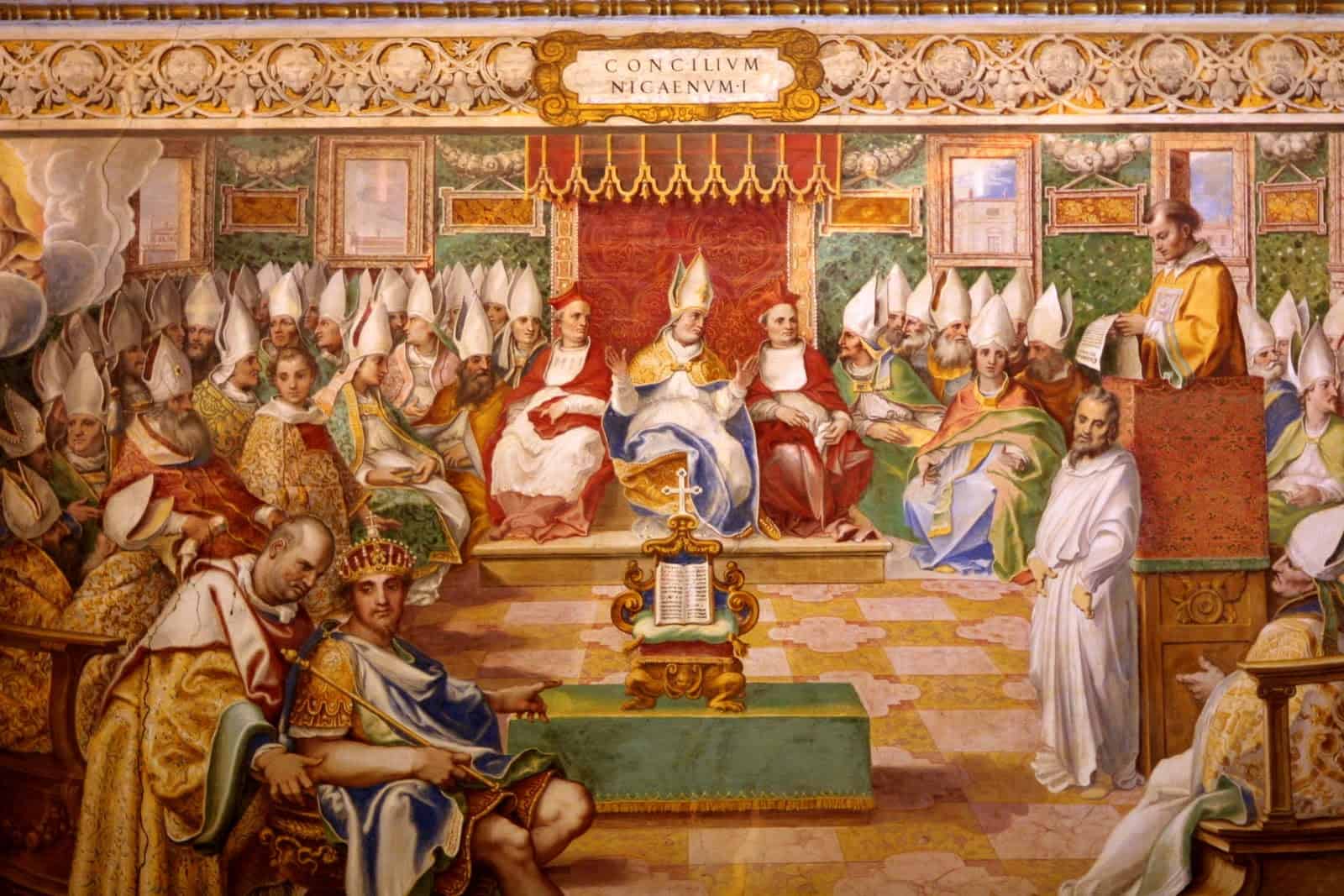While we got a good start in our series on the Creeds last episode, it behooves us to back up a bit and do a brief review of what we’re talking about when we look at the Creeds. There are four terms we need to define as sometimes they get confused; creeds, confessions, catechisms, and their relationship to councils.
The English “creed” comes from the Latin credo & means “I believe.” While some tomes assign more exacting terminology to define a creed, it simply refers a statement of faith. As given by the body or organization that issues it, it’s believed to be a faithful record of what has been handed down from earliest times, what Jude 3 calls “the faith that was once for all delivered to the saints.”
With the passing of the original Apostles and their direct heirs, the Church used as a standard what was called “the rule of faith.” In their writings, Church fathers like Irenaeus, Clement, Tertullian, and Hippolytus universally accept this “rule,” as they call it, as the indisputable summation of what the Apostles had taught. That rule became the core and basis for later Creeds, including the Apostles Creed that we talked about last time, and the Nicene Creed, which is reckoned by many as the first official Church Creed.
CS has an audience & subscriber base of people all over the world. Many live in cultures that are highly communal. But the vast majority of our listeners are based in Europe and North America which tend to be dominated by individualistic cultures where people generally have the freedom to pick and choose what they want to believe. Religion and philosophy is a smorgasbord affair where people take a little of this, a smattering of that, and a scoop of this other. When it comes to pick a church to be a part of, in most modern communities, they have dozens to choose from. There’s a good chance they can find one that’s lines up closely with their preferred religious options, as hybridized as they may be. And of course there’s always the option to attend no church at all, choosing instead the well-worn rubric, “Well, you don’t have to go to church to believe in God.”
We need to be clear; both the smorgasbord approach and opting out of fellowship were simply not acceptable to early believers. To be a Christian meant to be a part of a local fellowship. That fellowship was defined by definite parameters and clearly stated propositions. A creed wasn’t just a summary of what everyone agreed to; it was a promise made and kept as a group.
The best evidence we have is that a creed was taught to a new believer as part of her/his preparation for baptism. Being short, they were easy to learn. And we’re talking about a culture without the abundance of books we have today. All their education had come by way of memorization. Each line of the creed was explained in depth in a question and answer format. Then, the candidate recited the creed from memory as they were baptized. It was THAT faith, the one they’d just confessed, they were being baptized into.
These early creeds were often recited in unison when the church met. Later, longer and far more elaborate liturgies evolved from this. But in the first centuries, creeds weren’t complex formulas handed down form some ivory tower. They were the way both slaves & their masters, smiths, merchants, and farmers all learned about and pledged themselves to God.
Twenty-first C Christians, being literate, and owning dozens of books comprising a library an ancient king would envy, may wonder what purpose a creed serves today. When we can own a Bible in a half-dozen versions, what need is there of a creed? Some even go so far as to regard creeds as standing in opposition to Scripture. Theologian John Webster suggest we regard creeds as a way to hear the Gospel. We don’t discern the truth of Scripture as an autonomous judge and jury. The creed becomes a safety net that says, “This is how the Body of Christ at large has understood The Faith.” Creeds are a distillation of the core elements of The Gospel. A creed doesn’t impose dogma on Scripture; it is instead the truth of God’s Word, in other words.
In contrast to a creed, a confession is more detailed in its description of the things of God. A creed sets the boundaries of the Christian faith, making a clear distinction between orthodoxy & heresy. And that’s largely why there developed different creeds. Some new challenge was leveled against some aspect of the Faith. Church leaders then met to address it and produced a new & updated creed. A Confession elaborates on a Creed.
Consider a child’s coloring book. It’s filled with pages of simple black & white line drawings. That’s the creed. It lays out the figure of The Gospel in bold clear lines. A confession colors in those lines. The earliest creeds were simple, much like the figures in a young child’s coloring book. Later creeds became more complex, like the figures found in adult coloring books that recently have become all the rage. Later in Church History, different groups added to these more complex creeds and colored them in to produce the plethora of denominations we have today.
CS Lewis likened a Creed to a great hall into which all believers gather. Off that hall are many doors leading to rooms filled with cozy chairs, fireplaces and tables set with a delicious banquets. Those rooms are the various confessions people move into to experience how The Faith interfaces with their daily lives.
Confessions are the distinctive that carve up the Church into different denominations. They are often expressions of a group’s belief on secondary issues. Things like, how baptism ought to be conducted, the order of End Times events, the nature of Predestination, how to conduct Communion, and the on-going role and work of the Holy Spirit.
Typically, a Confession says, “This is what makes us, us, and not someone else.” Those who hold to a particular confession ought to do so with a sense of committed loyalty, while at the same time acknowledging that what composes that confession are secondary issues, and don’t rise to the level of a creedal border that defines THE Faith.
There are two major kinds or orders of Confession. The first are those produced by the Reformation & Counter-Reformation. Subscribers to CS will remember them by such titles as . . .
- The 39 Articles of 1563 which marked out Anglicanism.
- The Lutheran Formula of Concord in 1577
- 1621’s Arminian Confession
- The Westminster Confession, laying the foundation for Presbyterianism in 1646
- The Methodist 25 Articles of Religion, 1784
- The Roman Counter-Reformation’s Council of Trent that produced The Confessions, in a monumental council lasting 18 yrs, from 1545-63
- Vatican II, from 1962–65
Second tier Confessions arose as the different denominations the First Tier Confessions carved out attempted to apply the faith to emerging issues. The Chicago Statement on Biblical Inerrancy and the Lausanne Covenant are of this second tier. Each of them articulated a specific church’s, and in many cases, a group of churches, response to a specific theological issue regarded as being of great importance. These secondary Confessions are usually regarded as supplemental. They aren’t a complete statement of a church’s position on the entire Faith; just a portion of it that is currently under contemporary review. So the Chicago Statement of Biblical Inerrancy addressed the issue of that framed the Liberal vs Fundamentalist debate. The Lausanne Covenant addressed issues of contemporary world missions.
The word “catechism” comes from the Greek word katechein, meaing “to teach; instruct.” Catechisms are basic outlines of the teachings of the Christian faith, set forth in a way those unfamiliar with doctrine can readily grasp it. The best way to think of a catechism is as an instruction method. It gives a brief summary of The Gospel in Q&A form. Catechisms merge elements from both Creeds & Confessions into practical, pithy sayings that capture the main tenants, not only of THE Faith, but its particular flavor the catechism comes from.
Catechisms were used in the Early Church, since the origin of the method was in the education of children long before. During the First Centuries, the Church saw it as imperative to inculcate a rich set of firmly held beliefs in new converts. This was because these new believers were converting out of a paganism derived from a worldview fundamentally different from a Biblical one. Cyril of Jerusalem described the process this way: “Let me compare the catechizing to a building. Unless we methodically bind and joint the whole structure together, we shall have leaks and dry rot, and all our previous exertions will be wasted.”
But Catechisms weren’t just a tool for the Early Church. They were alive & well in the Middle Ages. Thomas Aquinas wrote one based on the Apostles’ Creed.
But it’s the Reformation that’s known as the Golden Age of Catechisms. Martin Luther, wrote 2 catechisms, a shorter & longer. He put the burden of teaching the Faith via the catechism oin parents rather than the church. John Calvin also regarded the catechizing of converts and children to be of utmost importance. He said the success of the Church was dependent on how well it raised its youth in the things of God. The Puritan divines John Owen and Richard Baxter both wrote several catechisms for different age groups.
Catechisms weren’t meant as an end in themselves. They were meant to lead to belief, practice, and a love for God & man that would draw those who’d been catechized into a deeper and hopefully self-directed investigation into the Creeds & Confessions.
From the beginning of the 4th C, most of the classic Creeds of the Church were the product of gatherings of Church leaders called councils. These brought together bishops, elders and scholars from all over the world to address issues that had arisen as points of debate or contention. The challenge of heresy, often beyond the intellectual capacity of a local pastor to address alone, was clarified, parsed, & analyzed in light of God’s Word by those best qualified through knowledge and gifting to deal with. Think of these councils as a Spiritual CDC – Center for Disease Control. Some new religious infection sprang up and began to infect churches. A Council was called to meet at a specific place on a set date. When the bishops & scholars arrived, they each shared their experience with the infection, laying out a clear picture of what was wrong. Then they went to work dissecting it with the scalpel of Scripture. They developed an antidote, which each pastor-bishop then returned home with a doctrinal syringe to inoculate the people of his church and city. That syringe was a Creed. Or better, not an entirely NEW Creed, but the old one, with some verbiage that had been added or edited that brought greater clarity to very issue the heresy had sought to hijack.
All major branches of the Church, Orthodox, Catholic, & Protestant, recognize 7 what are called Ecumenical Councils that frame the Creedal foundation of the Church. There have been an additional 14 Catholic councils.
The first council is found in Acts 15 the New Testament when there was a controversy over how to handle the large number of Gentiles who were coming to faith in Jesus. One group assumed they had to, in effect, convert to Judaism as part of their Faith in Jesus as the Jewish Messiah. Another group said it was unnecessary for Gentiles to come under the Mosaic Law since they’d entered the Covenant through Faith in Christ. This Jerusalem Council decided that Gentile converts were to abstain from those things that would hiunder fellowship with their Jewish brothers & sisters but they did NOT have to become Jewish or keep kosher. The Council made this a policy that was to be followed in ALL churches.
Like that first Council, later councils were called to address not just disagreements over theological issues but the impact correct doctrine had on the practice of the Faith in daily life.
The question that rises is, “Were a Councils’ decisions authoritative? And how were its decisions enforced?” Ahhh – there’s the rub.
We can look to what Paul says in 1 Cor. 8 in regard to whether or not believers can eat meat sacrificed to an idol. For his guidance, Paul did NOT look to the finding of the Jerusalem Council as the authority. He instead looked to the revelation he’d received from Christ. Paul regarded the Jerusalem Council as holding some measure of authoritative but not ultimately or definitively. He appealed instead to God’s Word as the arbiter of truth, not a council of fallible human beings.
While the first couple councils were purely pragmatic responses to a pressing need, their success in handling those needs created within Church leaders a more careful consideration of the value of Councils. Their composition took more thought. They brought together Christians leaders from all over. It wasn’t just the best and brightest, the most popular preachers, or the loudest activists. It was a measured cross-section of Christian leaders from every corner. Their goal was a diversity of voices and perspectives that would each add to the overall understanding of the church’s unique needs and opportunities. They then asked the Spirit to guide their deliberations to arrive at a thorough-going Scripturally faithful solution to the issues at hand.
And while that was the ideal, it wasn’t always followed, as we’ll see. Some councils were little more than partisan brawls more concerned with politics than Scripture. Realizing that, we question whether their findings and the Creeds they produced are worth following. The answer is a careful yes, because even they knew some of the Councils went off the rails and moved to correct them by follow up Councils. And some of the problem councils still produced valuable results. We don’t reject a pearl because it comes from sand inside a slimy oyster. Some councils were oysters that produced pearls.
It was my intention to get to the First Council of Nicaea in this episode, but we can’t and stay in our time limit, so with all this now as our background, we’ll take a look at Nicaea, next time.





